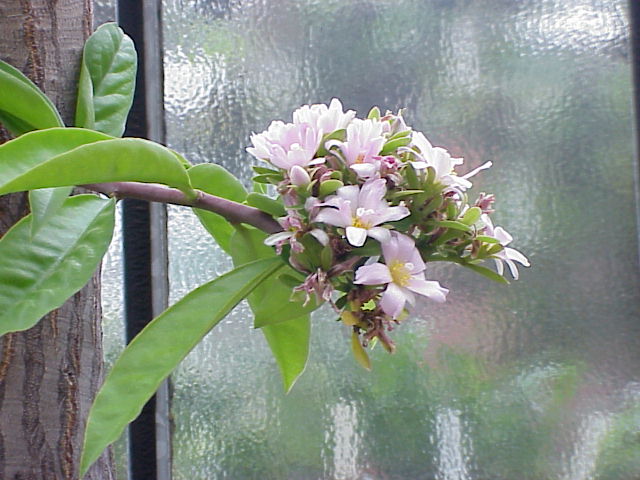- Pereskia
Taxobox
name = "Pereskia"

image_width = 240px
image_caption = "Pereskia grandifolia "
regnum =Plant ae
divisio = Magnoliophyta
classis = Magnoliopsida
ordo =Caryophyllales
familia =Cactaceae
subfamilia = Pereskioideae
genus = "Pereskia"
genus_authority = Mill.
subdivision_ranks =Species
subdivision = See text."Pereskia" is a
genus of about 25tropical species and varieties of cacti that do not look much like other types of cacti, having substantial leaves and thin stems. They originate from the region betweenBrazil andMexico . The genus is named afterNicolas-Claude Fabri de Peiresc , a 16th century French botanist, which also has been given its ownsubfamily Pereskioideae. Members of this genus are usually referred to as lemon vines, rose cacti or leaf cacti, though the latter also refers to the genus "Epiphyllum ".Species of "Pereskia" generally resemble other types of plants, such as
wild rose s. "Pereskia" species have large, bright green, privet-like leaves and long spiny stems. Not alwayssucculent plants, they can be classified as shrubs, climbing plants or slightly succulent trees. However, close examination shows spines developing fromareole s, and the distinctivefloral cup of the cactus family. UnlikePereskiopsis , "Maihuenia ,Quiabentia " and "Austrocylindropuntia " which have persistent succulent leaves, "Pereskia" is the only cactus genus that has persistent non-succulent leaves. It is believed that this is the origin of other cacti.Shrub species usually grow to 1m in height, but climbing or arborescent species can reach 5 to 20 m. Flowers may appear alone or in clusters. They generally resemble
rose s and reach a diameter of 1 to 5 cm. Colors of the flower depend on each species and vary from white, yellow to magenta or red. Fruits are ordinarily spherical, of 2 to 5 cm diameter, and arewine red when ripe.Most of the species are found in dry forests or thorny scrub, in tropical climates with a dry season of two to five months. They are found from southern
Mexico toColombia andVenezuela , and throughout theWest Indies , as well as the eastern part ofBrazil south to northernUruguay andArgentina . Several types are native to theAndes inPeru andBolivia , though not on the Pacific side. They have found in the US state ofFlorida , but are probably introductions rather than natives.Species
*"
Pereskia aculeata " -Barbados gooseberry
**"Pereskia aculeata" var. "rotundifolia"
*"Pereskia aureiflora "
*"Pereskia bahiensis "
*"Pereskia bleo "
*"Pereskia colombiana "
*"Pereskia corrugata "
*"Pereskia cubensis "
*"Pereskia diaz-romeroana "
*"Pereskia godseffiana "
*"Pereskia grandifolia "
**"Pereskia grandifolia" var. "violacea"
*"Pereskia guamacho "
*"Pereskia horrida "
*"Pereskia humboldtii "
**"Pereskia humboldtii" var. "rauhii" (syn. "P. horrida")
*"Pereskia lychnidiflora "
*"Pereskia marcanoi "
*"Pereskia nemorosa "
*"Pereskia philippi "
*"Pereskia portulacifolia "
*"Pereskia quisqueyana "
*"Pereskia sacharosa "
*"Pereskia stenantha "
*"Pereskia subulata "
*"Pereskia vargasii "
**"Pereskia vaugasii" var. "longispina"
*"Pereskia weberiana "
*"Pereskia zehntneri "
*"Pereskia ziniiflora "
*"Pereskia zinniaefolia "Most likely
Charles Plumier collected the first "Pereskia" specimens from theWest Indies between 1689 and 1695, but none of these have survived. Although Plumier described "Pereskia" in 1703, Linnaeus placed Plumier's two species in his "Cactus", as "'C. pereskia" and "C. portacifolius".Philip Miller brought the original name back in 1754, and so by the rules ofbotanical nomenclature , he is credited as the author.The genus "Rhodocactus" (
A.Berger )F.M.Knuth has been brought intosynonymy with this genus, as well as different orthographic variants: "Peirescia"Zucc. (orth. var.), "Peireskia"Steud. (orth. var.) and "Perescia"Lem. (orth. var.).Uses
The genus is not of great economic importance, the most common usage being as
hedge s;they are easily transplanted and quickly grow into an impenetrable thicket, as well as flowering prolifically. Being more tolerant of moisture than more succulent cacti, they can be used as rootstock for grafting of "Zygocactus " to create miniature trees.Pereskias have been naturalised in the
Caribbean , theWest Indies andWest Africa .These species contain
tyramine , andphenethylamine .References
*
Edward F. Anderson , "The Cactus Family" (Timber Press, 2001), pp. 566-572
*Beat Leuenberger , "Pereskia (Cactaceae)", Memoirs of the New York Botanical Garden 14 (1986)
Wikimedia Foundation. 2010.
